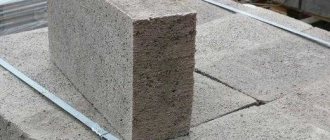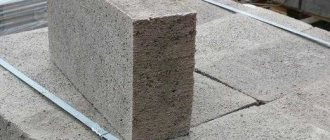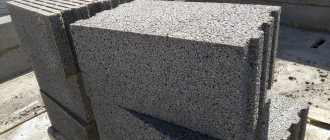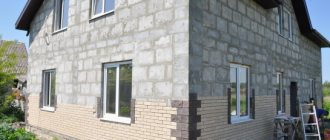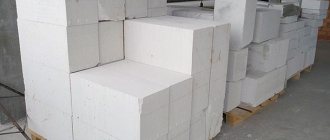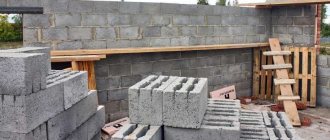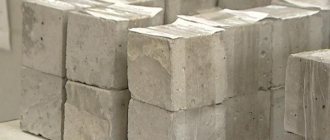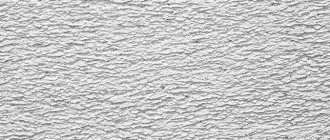A huge number of building materials allows any buyer to purchase something specific, more suitable for a particular case. Sand concrete blocks are especially popular in the construction of private houses and other structures. Like other materials, they have their own advantages and disadvantages. The choice of sand concrete blocks is made taking into account the nuances of construction work and future operation of the facility, and the availability of available funds.
Kinds
Conventionally, sand concrete blocks are divided into several types, differing in their characteristics:
- Foundation or solid block. It has no hollow areas, which is why it is considered quite durable. Used for the construction of foundations. Regular dimensions are 20 x 20 x 40 cm.
- Hollow. It has a certain number of voids - from 2 to 8. They differ in sound insulation and thermal characteristics. The strength is good, but the consumption of raw materials is significantly reduced. The main purpose is for load-bearing walls.
- Facing. It is distinguished by decorativeness on one side and is used for exterior wall decoration. No additional processing required. The main advantages are water permeability, strength indicator, resistance to various temperature conditions.
- Septal. Used for the construction of internal walls, it is smaller in size and has excellent sound insulation. To improve this quality, hollow material is used in combination with such a block.
- Wall. Used for the construction of external internal walls, characterized by increased width.
Preparing the foundation for laying cinder blocks
- Elimination of foundation unevenness.
Before starting masonry, the surface of the foundation should be cleared of excess debris and dust. Knock down and eliminate existing irregularities as much as possible in those areas of the foundation where the masonry will be done. This can be done with a pick, hammer, or special spatula. Then thoroughly sweep away all debris and dust from the surface of the foundation.
- Foundation waterproofing.
If your foundation has not been waterproofed. Then the places for masonry need to be covered with mastic or a layer of waterproofing material. This protects the cinder block from excess moisture from below.
- Height and width of the foundation. Ideally, the width of the foundation on which the cinder block will be laid should be 40 cm wider than the width of the wall itself. And the height of the foundation under a cinder block wall should be at least 70 cm from the ground level. This height is necessary so that the cinder block, which absorbs moisture well, is as high as possible from the ground. In practice, such proportions are often not observed. If the facade of a cinder block building is additionally protected from the external environment, then the proximity to the ground will not cause harm to the cinder block, or it will be insignificant.
- Provide easy access to cinder block laying areas. Access to the perimeter of the masonry must be free both from the inside and from the outside of the foundation. This will make it easier to bring the cinder block and mortar to the masonry areas, and will make it easier to work with masonry on both sides of the wall.
waterproofing the foundation before laying
Compound
Classic version of the feedstock:
- cement composition – 1 share;
- sand - 3 shares.
If you use a sand-gravel mixture, the required amount of solution is reduced.
Portland cement can be added as additional components to give the material additional resistance to frost, improve density and ability to resist corrosive formations.
In addition to preparing the solution yourself, it is possible to purchase a prepared sand-cement mixture with large and small fillers. The first option has a high strength index and is used as an independent material. The second type is used for facing work.
Mortar for laying cinder block
Making your own mortar is the cheapest masonry option. Purchasing ready-made families, to which you just need to add water, will make the masonry noticeably more expensive.
We will take the size of one bucket per measurement portion.
Composition of masonry mortar
- One bucket of cement
- Three buckets of sand
- Half a bucket of water. The indicated amount of water is not strict. The amount of water is regulated by the viscosity and liquid of the resulting solution. If the sand is wet, less water may be needed.
- Strength plasticizers. Additional fastening liquids and mixtures can be added to the solution. But they are not required.
- It is recommended to add one cap of dishwashing detergent along with water for one batch of cement mortar. This additive will make the solution elastic and stretchy, which will make it easier to work with.
If you mix the solution manually, using a shovel, then pour the cement and sand into one container and mix them well until the mass is as homogeneous as possible.
Before adding it to the dry mixture, add a portion of dishwashing detergent and a plasticizer to the water. After mixing everything until a homogeneous liquid, the water can be poured into the central part of the container with the dry mixture.
Requirements for mortar for laying cinder block:
- Uniformity of color. The solution must be stirred until it reaches a uniform gray color.
- The solution should be of medium viscosity, not too thick, but not too liquid, so that it adheres ductilely and well to the masonry and does not drain under the pressure of the cinder block.
- If unmixed fragments of yellow sand are visible in the solution, then it must be continued to be stirred. If you find solid fragments of soil, stones, or some kind of vegetation that accidentally got into the solution, then they should be removed from the mixture. Poor homogeneity with sand stones and other substances will lead to cracking of the masonry in the future.
In order to reduce the cost of effort, it is advisable to use a concrete mixer. But for a mixture of small volumes of solution, it is more practical and faster to mix the solution by hand.
in a well-mixed solution no sand should be visible
Specifications
What are these, sand concrete blocks? To answer this question, you should study their technical parameters:
- resistance to freezing - from 50 to 75 cycles;
- strength indicator – 200 – 500;
- density – 1,300 – 2,200;
- parameters, cm – 20 x 20 – 40 (10 x 20 – 40);
- ability to conduct heat – 0.56 – 1.15;
- moisture absorption – up to 8%.
All characteristics of the elements depend on the type, size, and technological manufacturing features.
The material has good density and is considered reliable. As an addition, sand concrete blocks have the following characteristics:
- ready for use after 50 days;
- setting in three hours;
- the ability to use the solution for two hours;
- material consumption – 1.8 kg per cubic meter.
Making blocks
The production of sand concrete blocks is carried out using volumetric vibrocompression.
Quartz sand used to make the mixture improves the strength of the blocks. To improve the quality of elements, various modifying components are added.
The proper quality of the finished product can only be ensured by industrial production with modern equipment.
The following factors may affect product quality:
- use of raw materials that meet standards;
- strict adherence to the technological process;
- maintaining technology and proportional ratios of components;
- organization of control over the production process.
The market also presents products made by hand in home workshops. Such units should be purchased with the obligatory study of the technological production process and a certificate confirming the quality of the product.
The workshop producing blocks must be equipped with:
- dispenser;
- mixer;
- vibropress;
- forms.
You should not try to save on a building that is planned to be used for a long period.
Making sand concrete blocks involves performing the following steps:
- The necessary components are selected according to the appropriate characteristics.
- The ingredients are dosed and sent to the mixing plant.
- During the vibration process, the mixture should be shaken periodically to ensure its homogeneity.
- Various matrices are used for blocks. With their help, different types of products are produced.
- The mass is transferred into molds made of steel material. Due to its density, it almost does not delaminate.
- To speed up the process, drying is carried out using thermal or infrared installations.
- The blocks are removed from the molds and sent to the warehouse to gain strength.
- Drying continues at room temperature, normal ventilation and sufficient humidity.
- The finished products are stored on pallets and wrapped in film.
How to correctly place blocks according to type
Laying blocks has its own specifics depending on the characteristics of the building materials.
Expanded clay concrete blocks
Products made of concrete and foam clay (expanded clay). Special cavities inside the block can be reinforced. We protect the foundation from moisture using rolled roofing material, fixing it on a cement screed. The laying of blocks is carried out from the corner along the perimeter of the marking, checking the horizontalness of the masonry on the plane. The main thing is that the beginning and end of the masonry are at the same level. In a ridge-type system, there are no through gaps, which is why vertical seams do not need to be filled with building compound.
The horizontal seam should not be thicker than ten centimeters. Build walls: load-bearing and interior at the same time. For installation, you can use a concrete mixture and adhesive composition. It is recommended to erect non-load-bearing walls 2 cm lower than load-bearing ones, which will significantly reduce the pressure from the ceilings on the partitions. The gap that appears as a result of this technique can be filled with polyurethane foam.
Aerated concrete blocks
They are also called gas silicate. They are characterized by porosity, which over time causes a decrease in the density of the material and the appearance of cracks. The building is being destroyed. But in order to avoid problems, you need to take care of reliable waterproofing and preliminary reinforcement of the walls. After finishing laying the blocks around the perimeter, take a break for 12 hours.
Laying concrete blocks is quick and easy, which is facilitated by the small weight and size of the blocks. Such concrete blocks can be laid using glue or cement. When installing using cement, it is recommended to make the seam within 6-10 mm, and the device on a cement mixture - no more than 3 mm. Before erecting the structure, make sure that the foundation is level and has secured waterproofing.
For concrete blocks, you can prepare a solution in a 4:1 ratio of sand and cement. The bottom of the building material must be moistened, otherwise the aerated concrete can “pull” moisture out of the solution, and the wall of such a structure will be unreliable. Start building walls from the point where the foundation has a surface above. To determine such a place, use the building level. It is very important to lay the first row horizontally, then they can be glued together. Starting from the fourth row of blocks, you need to install reinforced metal or fiberglass reinforcement with a diameter of 8 mm. Aerated concrete walls are plastered with gypsum plaster, which will protect against moisture and damage. Aerated concrete blocks are used when decorating loft-style rooms.
Foam concrete blocks
They are distinguished by a polished surface, which is their advantage, since you will not need to spend money on materials to level the walls.
Step-by-step instructions on how to lay foam concrete blocks:
- You need to start by applying a mixture of sand and cement 2 cm thick to the foundation, then insulation from moisture (bicrost, roofing felt).
- We move on to the first row, filling the voids formed in the seams.
- To distribute the adhesive composition in a uniform layer, you can use a construction spatula. The seams need to be filled. In the case of using cement mortar when constructing walls and installing walls, the blocks must be moistened with water due to the porosity of the material itself. Plasticizers can also be added to the solution to improve its quality.
Construction recommendation: make non-load-bearing walls 2 cm lower than load-bearing ones, which will reduce the pressure of the floors on the partitions. The gap that is formed as a result of the opening can be sealed with foam.
Cellular blocks
The first thing you should pay attention to is leveling the base, then you need to wait for the foundation to harden. Once you are convinced of its strength, you can proceed to work. To build blocks, use glue, and for the first row, use a cement-sand mixture. To increase plasticity, liquid soap or a plasticizer can be added to the solution. As a rule, wall construction should be carried out from the corner, adhering to the direction: one row in one direction, the other in the opposite direction. After installing the corner elements, the construction of walls begins.
Advantages
Sand-cement block material is widely used in the construction industry due to its special qualities that make it possible to build strong and stable objects, the cost of which will be relatively low. With the use of such building materials, the cost of construction work is halved.
The clear advantages of sand concrete blocks are:
- level of strength - this quality is especially inherent in solid elements that are allowed to be used for arranging foundations;
- service life reaching sixty to one hundred years;
- economic effect - the volume of a block is equal to seven bricks, to build a wall you will need less mortar, labor costs will be reduced;
- hollow blocks are lightweight;
- structures made from this material can be reinforced;
- the object will withstand severe frosts and other negative impacts;
- the biological stability of the blocks places it in group V. The material is perfectly protected from mold and mildew;
- fire resistance - the block does not lose its characteristics within ten hours of exposure to open fire;
- the ability to quickly carry out construction work, no shrinkage;
- reasonable cost of material;
- environmental cleanliness;
- the air in the void areas will be an excellent heat insulator.
Flaws
It is quite natural that the material is not considered an ideal option for construction. It has certain restrictions in use, which define the boundaries of application. If you do not take them into account, you will end up with a building of poor quality that will not be in use for long.
So, the negative points are:
- Mass of a solid block. It reaches fourteen to eighteen kilograms, which complicates the work process. There is a need to lay down serious foundations.
- Weak thermal insulation properties. The air holds heat, but the material of the product itself easily releases it; the walls need a serious insulation layer. In such cases, it is necessary to forget about saving money and labor costs.
- A hollow block is not able to withstand heavy loads. Weak strength and the presence of voids do not make it possible to construct buildings exceeding two floors from such blocks.
- Quite often blocks do not have ideal geometric parameters.
- The quality characteristics of the finished material differ among manufacturers.
Reviews from experts
Having studied all the pros and cons, the masters came to clear conclusions. Sand concrete blocks make reliable plinths. The strength of this material is an order of magnitude higher than that of many analogues used for similar work. Construction costs are reduced and the load on the foundation is reduced.
If you use solid blocks to build walls, you will have to install a serious insulation layer. Otherwise, the house will be cold, which will entail costs for heating the premises. In such cases, it is recommended to use hollow sand concrete blocks.
Mostly reviews about this material are positive. The indoor temperature remains comfortable at any time of the year. If you use lined blocks, then finishing the outer sides of the walls will not be required, which will help save money.
Cinder block laying technique
Laying the first row of cinder blocks.
After completing all the above steps, you can proceed directly to laying the cinder block. The most important step after correct marking is laying the first row of cinder blocks.
- Laying the first row of cinder blocks begins from the corners of the foundation to the middle of the wall row.
- The prepared cement mortar is laid out on the foundation along the width and length of the cinder block. The optimal thickness of the solution is 1.5-2 cm. The solution is also applied to the end of the cinder block.
For laying mortar, especially for beginners, it is convenient to use a special construction device: a template for laying blocks. You can construct this device yourself or purchase it in a store.
template for laying mortar using the example of brickwork
- The cinder block, along a stretched cord from the corners, lies on the already laid mortar. Using a hammer or pick, the top is knocked into the same plane as the corner cinder block. The correct horizon from above is measured by the building level.
In the same way, the walls are laid from other corners of the foundation, towards each other.
- After the blocks are as close as possible in the central part of the row. It is necessary to measure the length of the last block along the foundation and cut it with a grinder to a suitable size. In the same way, lay the remaining block in a row along the cord and horizontally.
How to cut a cinder block
The easiest way is to cut the cinder block into the required size using a grinder. The circle used must be at least 150 mm - 200 mm. The cinder block is marked over the entire surface, on all sides, with chalk or pencil. Then, using a grinder, the cinder block is sawed around the entire perimeter. A wooden wedge is inserted into the cuts and thus the block is split in the middle. When working with an angle grinder, be sure to take safety precautions: use a mask or goggles, cut on a solid surface, secure the cinder block well.
cutting cinder block with a grinder
- Having laid the block flat and to size, remove excess mortar from the seams and from the bottom of the cinder block.
- The first row of cinder blocks must be reinforced with mesh or reinforcement.
